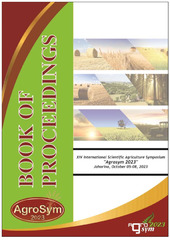Приказ основних података о документу
THE EFFECT OF DIFFERENT MICROBIAL FERTILIZERS ON THE WEEDINESS OF SOYBEAN
| dc.creator | Dolijanović, Željko | |
| dc.creator | Simić, Milena | |
| dc.creator | Oljača, Snežana | |
| dc.creator | Poštić, Dobrivoj | |
| dc.creator | Đorđević, Snežana | |
| dc.creator | Šeremešić, Srđan | |
| dc.date.accessioned | 2024-01-09T11:47:25Z | |
| dc.date.available | 2024-01-09T11:47:25Z | |
| dc.date.issued | 2023 | |
| dc.identifier.issn | 978-99976-816-1-4 | |
| dc.identifier.uri | http://aspace.agrif.bg.ac.rs/handle/123456789/6717 | |
| dc.description.abstract | The experiment with low-input technology of soybean was conducted at the research and study field "Radmilovac", Faculty of Agriculture Belgrade in 2022 on the luvic chernozem soil type, in completely randomized blocks. Cropping system included tillage with a disc harrow at 20-25 cm with the complete previous crop residues incorporation and the presowing tillage with a harrow. The basic fertilization was conducted in autumn with 300 kg ha1 NPK (15:15:15). For top dressing in spring, the following microbiological fertilizers were applied: biofertilizer ("Slavol", manufacturer "Agrounik" Serbia) with 5.0 l ha-1 in two treatments and Eko lame 10 l ha-1 in three treatments. The top dressing in the control variant was done with nitrogen fertilizer AN at the rate of 40 kg ha-1 N. The soybean (NS Maximus) cultivars were used. The crop was grown in a six-crop rotation (winter wheat-maize-spring barley+red clover-red clover-soybean-sunflower). Statistical analysis confirmed that top dressing had a greater effect on weediness of soybean. The weed community in investigated crops consisted of 11 weed species, with dominating: Solanum nigrum L., Polygonum aviculare L. and Avena fatua L., (annual species) and Convolvulus arvensis L. and Sorghum halepense (L.) Pers. (perennial species). The obtained results show that the highest number of weeds, weeds per species, fresh and air-dry biomass were recorded in the control treatment. The statistically lowest values for the number of weed plants per species were recorded in the treatment with Eko lame, but for fresh biomass in the treatment with Slavol. The differences in weediness in the variants with microbiological fertilizers were not statistically significant, while there were statistically very significant differences compared to the control. Application of microbiological fertilizers affected the initial faster growth of soybean plants and increased competitiveness against weeds. | sr |
| dc.language.iso | en | sr |
| dc.publisher | University of East Sarajevo, Faculty of Agriculture, Republic of Srpska, Bosnia | sr |
| dc.publisher | University of Belgrade, Faculty of Agriculture, Serbia | sr |
| dc.publisher | ... | sr |
| dc.relation | info:eu-repo/grantAgreement/MESTD/inst-2020/200116/RS// | sr |
| dc.rights | openAccess | sr |
| dc.rights.uri | https://creativecommons.org/licenses/by/4.0/ | |
| dc.source | BOOK OF PROCEEDINGS, XIV International Scientific Agriculture Symposium “AGROSYM 2023”, Jahorina, October 05 - 08, 2023 | sr |
| dc.subject | competition | sr |
| dc.subject | weed | sr |
| dc.subject | soybean | sr |
| dc.subject | top dressing | sr |
| dc.title | THE EFFECT OF DIFFERENT MICROBIAL FERTILIZERS ON THE WEEDINESS OF SOYBEAN | sr |
| dc.type | conferenceObject | sr |
| dc.rights.license | BY | sr |
| dc.citation.epage | 382 | |
| dc.citation.spage | 378 | |
| dc.identifier.fulltext | http://aspace.agrif.bg.ac.rs/bitstream/id/25547/bitstream_25547.pdf | |
| dc.identifier.rcub | https://hdl.handle.net/21.15107/rcub_agrospace_6717 | |
| dc.type.version | publishedVersion | sr |


